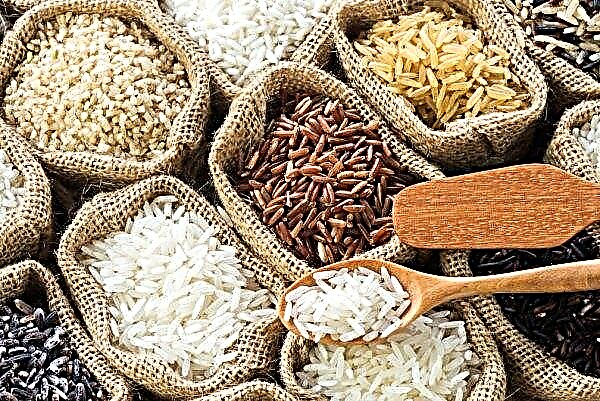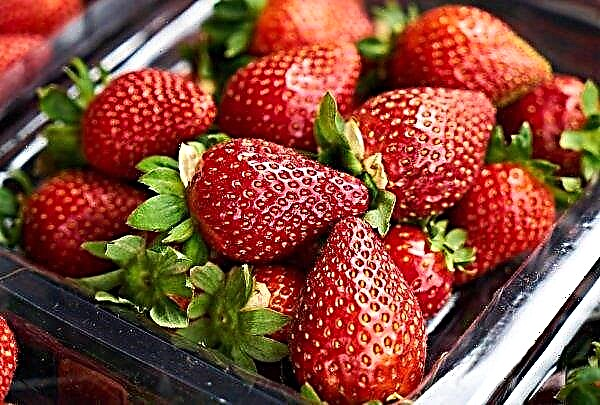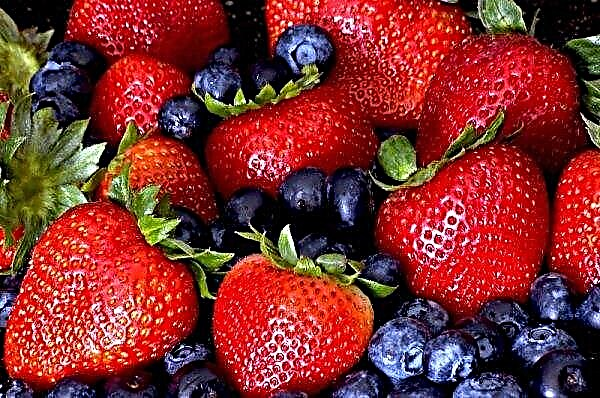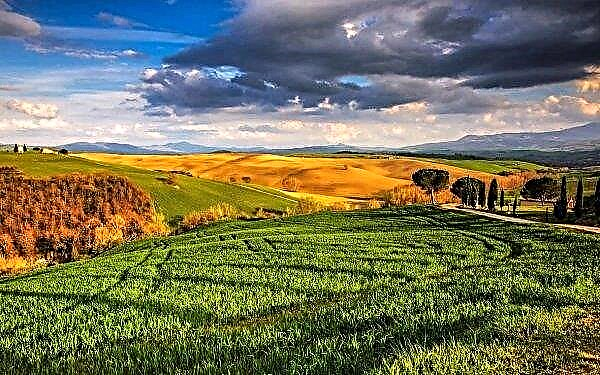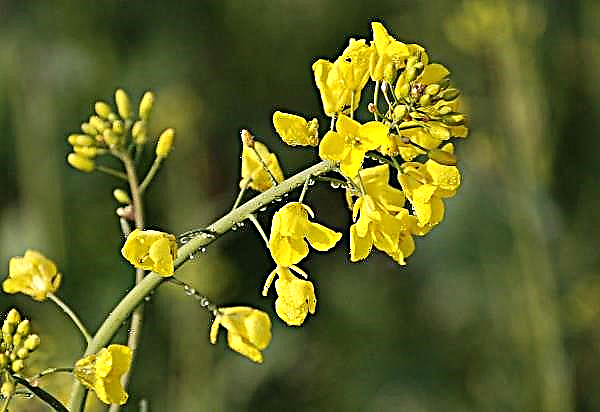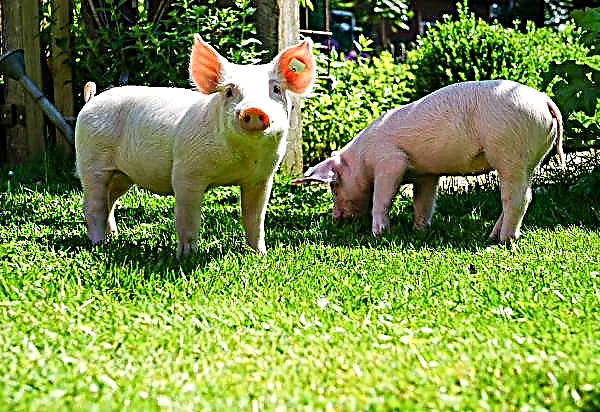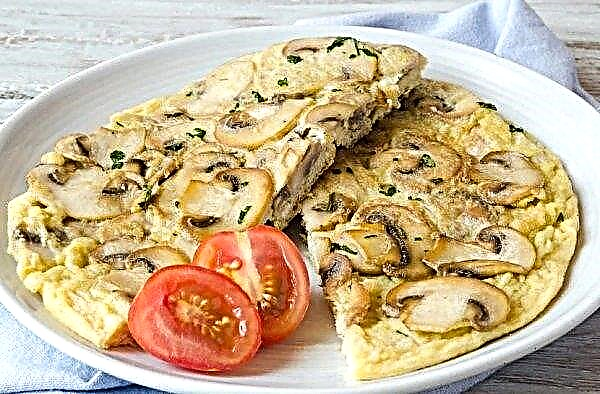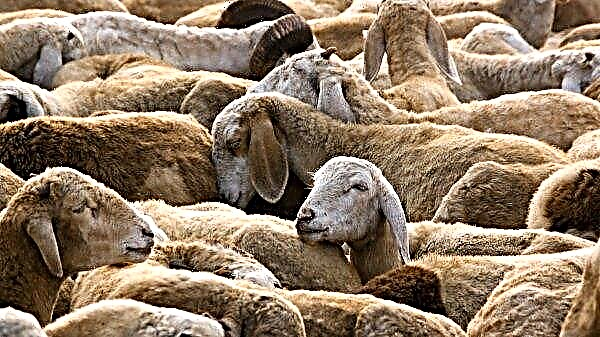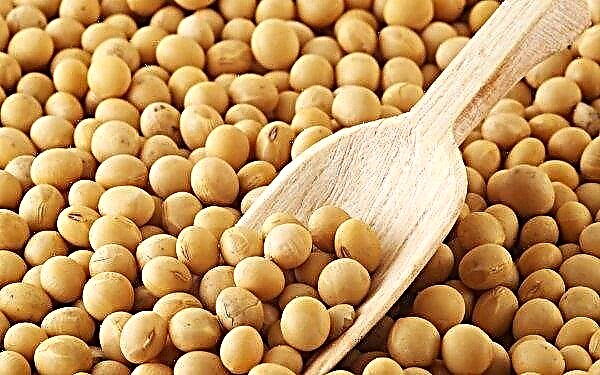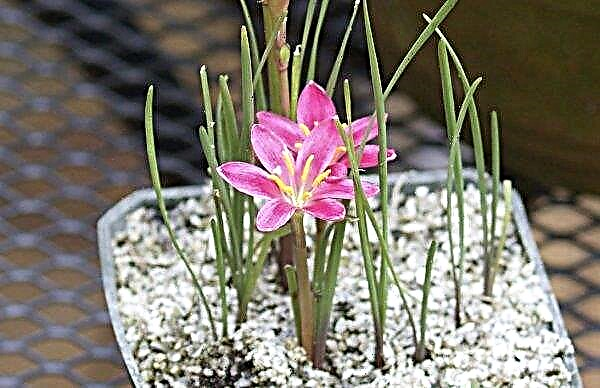The universal high-yielding variety of bell pepper Golden Miracle has been very popular among farmers for more than 10 years. The culture has good adaptive abilities and has a wide scope. About the main advantages of the variety, as well as the rules of cultivation, read below.
History and description of the variety
Pepper Golden Miracle was launched not so long ago, but thanks to many advantages it quickly gained popularity among residents of Russia, Ukraine, and Moldova. A characteristic feature of this pepper is a high percentage of seed germination.
Did you know? The use of bell pepper affects the human body in the same way as the use of chocolate, contributing to the increase in the blood of the hormone of happiness - endorphin. But, unlike chocolate, bell pepper cannot be the reason for adding extra centimeters at the waist.
Selection
The variety belongs to varieties of universal application and was developed by the “Search” selection agricultural company in Russia in 2000. In 2007, a culture that passed a series of tests was included in the State Register of Russia. According to the recommendations of the State Register, it is suitable for cultivation in open and closed ground in any region of the country.
Fruit Characteristics
Large-sized fruits have an elongated cuboid shape with well-defined faces. Painted in bright yellow. The skin is glossy, smooth to the touch. In length, the fruits reach 12 cm; weight is quite large - about 250 g. The walls are dense, fleshy, 8 mm thick. The flesh of the walls is juicy, sweet in taste.
Inside the fruit is divided into several sections with a small amount of seeds.
Fruits of universal purpose, subject to certain conditions, retain their presentation for 2 months. Perfectly suitable for fresh consumption, as part of side dishes and main dishes. Golden Wonder Pepper is actively used in winter harvesting.
High commercial qualities and resistance to mechanical damage make the variety interesting not only for private farms, but also for industrial enterprises.
Bush characteristics
The culture belongs to mid-early varieties. The period of physical ripening of the fruit is from 100 to 130 days, depending on the climatic characteristics of the growing region.
Semi-spreading bushes grow up to a maximum of 70 cm in closed ground, up to 50-60 cm in open ground. They are distinguished by a powerful root system of the fibrous type. Lateral shoots have a fragile structure, therefore, they often break under the weight of the fruit or with careless handling.
On the shoots, an average amount of large dark green leaves of a pointed shape is formed.
Cup-shaped flowers are arranged singly or ovaries of 2 pcs. Small petals frame the yellow middle. The plant is self-fertile, most of the flowers are female. Productivity from 1 m² is 5 kg. With good care from one bush per season, you can collect up to 20 fruits of high commercial quality.
Productivity from 1 m² is 5 kg. With good care from one bush per season, you can collect up to 20 fruits of high commercial quality.
Did you know? There is a special scale for measuring the hotness of pepper, which is called the Scovilla scale. Bell pepper takes the last place with a result from 0 to 100 units of hotness, and the sharpest pepper in the world Carolina Ripper takes the first position with a result of 2 million 200 thousand units.
Advantages and disadvantages
When choosing a variety of pepper for cultivation on the site, you should study its pros and cons in detail. This will make it possible to carry out preventive measures in time, as well as increase productivity.
- Advantages of culture:
- excellent climate adaptation;
- resistance to fusarium and some other fungal diseases;
- prolonged fruiting;
- excellent taste and presentation;
- the possibility of universal use;
- high seed germination rate;
- comparative unpretentiousness regarding leaving.
- The disadvantages of pepper Golden miracle:
- fragility of the terrestrial part of the plant;
- equally poor susceptibility and deficiency, and an excess of moisture in the soil.
How to grow seedlings at home
When working with this variety, it is best to use the seedling propagation method. This makes it possible to grow plants that are more resistant to negative factors.
The timing
Sowing seeds for seedlings should be carried out in early March. In the southern regions, it is possible to sow seeds in greenhouse conditions at the end of March, followed by transplanting into open ground.
The soil
For seed germination, fertile loose soil will be required. You can use the finished substrate from the store, intended for pepper, or mix it yourself.
In the manufacture of soil with their own hands in equal parts mix:
- peat;
- sand;
- leaf humus.
After the soil is prepared, it must be decontaminated. This can be done by calcining the mixture in the oven at a temperature of + 100 ° C.
There is another way to disinfect the soil - a hot solution of wood ash. 500 g of ash are added to 10 liters of water and boiled for 30 minutes. The hot solution is immediately poured into the soil, mixed and waiting for it to cool to + 20 ° C.
Important! Soil for seedlings is subject to mandatory disinfection treatment, regardless of whether it was bought in a store or mixed independently.
A solution of wood ash can not only disinfect the soil, but also enrich it with calcium, potassium and phosphorus.
Capacity
The following options can be used as containers for seed germination:
- general oblong boxes;
- separate plastic glasses;
- peat glasses;
- peat or coconut tablets.
When grown in shared crates, seedlings need to be dived 2 times, which is not particularly good for fragile plants. When germinating in a separate glass, you also have to pick, but once, in a permanent place. This process does not exclude damage to the fragile ground part when transshipped into a hole.
Based on this, it is better to opt for individual peat or coconut tanks. At the time of transplantation into open ground, they are placed in a hole with seedlings, where the container breaks up over time, further enriching the soil with mineral compounds.
Seed selection and preparation
When buying seeds in a store, you need to carefully read the annotations that the producer gives. Most often in production, seeds are pre-packed with growth accelerators and disinfectants, so additional soaking will only harm them.
Did you know? Bell pepper contains more ascorbic acid than lemon.
The seeds collected on the site and not processed are prepared in 3 stages:
- They are soaked in a warm (+ 30 ° С) 3% manganese solution for 1 hour, then the pop-up seeds are selected, and the seeds that settle to the bottom continue to be processed further.
- Soaked in a solution of “Kornevin” for 6 hours - 1 g of powder is added to 1 liter of water.
- Spread on wet cheesecloth and stand until the sprout is poked.

Sowing seeds
When planting in general containers, furrows are made in them, in which seeds are placed at a distance of 5 cm from each other. A distance of 7 cm is maintained between the furrows. One seed is placed in a separate container. Depth of landing when placed in any containers is 1–1.5 cm.
The surface of the landing containers is covered with cling film or polyethylene, and they are removed only after the first emergence.
Seedling Care
Before seed germination, containers are kept in dark rooms at a temperature of +25 ... + 27 ° С. Crops are aired daily, revealing a film; during ventilation, check the quality of the soil and its moisture. If necessary, the plantings are moistened from the atomizer with room temperature water.
With the advent of the first shoots, the films are removed and seedlings are moved to a well-lit window sill, preferably in the southeast.
From now on, plants need to provide:
- daylight hours within 12-14 hours;
- air temperature during the day - + 20 ° С, at night - + 18 ° С;
- soil moisture - 50%;
- humidity is 50-60%.
After the first true leaf appears, the plants grown in common containers are dived by transshipment method into a separate container. The second time the picking is carried out with the appearance of the 3rd sheet or not at all if a container of suitable size has been selected. The first top dressing is introduced with the appearance of the second true leaf - at this stage you can use a solution of “Kornevin” or ash. For watering, they are made according to the above schemes. Each plant takes 40 ml of working solution.
The first top dressing is introduced with the appearance of the second true leaf - at this stage you can use a solution of “Kornevin” or ash. For watering, they are made according to the above schemes. Each plant takes 40 ml of working solution.
20 days after the first top dressing, the soil is fertilized with urea: 40 g of urea is added to 10 liters of water. Consumption per plant - 50-60 g.
Watering is moderate; the soil should be slightly moist and loose. At the stage of growing seedlings, it is better to water from the finely divided spray gun with warm, settled water.
Seedling hardening
One of the main activities that allow you to get plants with high immunity is hardening seedlings. You need to start it 3-4 weeks before landing on a permanent place.
Important! In the period of getting used to the street climate, foliage may drop - this is a normal process.
Initially, the room temperature begins to gradually decrease to a similar outdoor temperature. When this stage is completed, seedlings begin to expose in the morning for several hours under the sun on a glazed balcony. Opening the windows there, gradually increase the interval of plants on the balcony.
A few days before planting, the plants are gradually accustomed to staying outdoors. To do this, they are exposed to a constant place of growth - first for 4 hours, then the interval is increased daily, based on the fact that the last day of seedlings should be spent at the planting site for 24 hours.
How to transplant seedlings to a permanent place
Productivity directly depends on the correct choice of a place for planting pepper and observing crop rotation rules.
The timing
Plants can be transplanted to a permanent place when the soil warms up to +12 ... + 15 ° С, and the average daily temperature is + 18 ° С. In the southern regions, pepper can be planted in mid-May, in the northern and central strip - not earlier than the beginning of June.
By the time of transplantation, the seedlings should reach a height of 15 cm and have several pairs of leaves. From the time of emergence of shoots to the final transplant takes about 60 days.
Did you know? Paprika juice can be used to replace facial tonic. After such a tonic, the skin becomes soft and radiant.
Seat selection and crop rotation
The area for pepper needs to be selected well-lit, closed on all sides from the wind. The distance to the groundwater should not be less than 1.5 m, otherwise the risk of root rotting is great.
Peppers can be returned to their original place of growth only after 3-5 years.
- The best predecessors and neighbors for pepper:
- cabbage;
- cucumbers
- legumes;
- cereals.
- Bad neighbors and predecessors:
- solanaceous;
- potatoes.
The soil for pepper is needed loose, nutritious. The ideal option is sandstone. The soil is prepared in several stages and begin to do so in the fall. The pepper area should be cleaned of plant debris and dug to a depth of 20 cm. Then treated with a 3% solution of copper sulfate, add 10 kg of peat, sand, manure per square meter and again dug to the same depth.
The soil is prepared in several stages and begin to do so in the fall. The pepper area should be cleaned of plant debris and dug to a depth of 20 cm. Then treated with a 3% solution of copper sulfate, add 10 kg of peat, sand, manure per square meter and again dug to the same depth.
In the spring, deep aeration is again carried out, treatment with copper sulfate. Instead of manure, superphosphate is added at this stage, 200 g per 1 m².
Scheme and depth of landing
The distance between the rows should be at least 50 cm. A distance of 35 cm is left between the bushes. The optimal hole size is 25 × 25 × 25 cm.
There is another planting scheme, involving the placement of 2 plants per well. In this case, a distance of 50 and 35 cm is maintained between the holes and the rows, and a distance of 5 cm is left between the bushes in the same hole.
A transplant from plastic glasses is carried out by the transshipment method. The day before the picking, seedlings need to be abundantly watered.
Important! It is best to transplant in the evening - if you dive in the heat, the plants wilted and will recover for a long time.
How to care for landings
Culture Golden Miracle is relatively not demanding in care. But, some agricultural rules still need to be followed.
Watering
Watering is carried out by a watering can with a long nose, equipped at the end with a spray nozzle. Plants respond well to sprinkling; the main thing is to carry out these procedures not in the heat, but in the morning or in the evening. The water temperature for irrigation should be similar to the ambient temperature. It is better to heat the water in the sun, and not artificially. Each bush takes an average of 2-3 liters of water. After transplanting, watering is carried out every 3 days. When plants take root, watering intensity is reduced to 1 time per week. In hot weather, it is better to water the plants with a small amount of water, but often - for example, add 0.5–1 l of water per well every evening.
Each bush takes an average of 2-3 liters of water. After transplanting, watering is carried out every 3 days. When plants take root, watering intensity is reduced to 1 time per week. In hot weather, it is better to water the plants with a small amount of water, but often - for example, add 0.5–1 l of water per well every evening.
Soil care
After each watering, you need to loosen the soil. The formation of a crust on the surface of the soil must not be allowed. Directly next to the plants, the soil must be loosened to a depth of 7 cm, between rows - 10-15 cm. In parallel with loosening, weeds are removed and plants are examined for pests and diseases.
After weeding, the soil is mulched.
As mulch you can use:
- peat;
- rotted compost;
- fresh green grass.
The height of the mulching layer must be at least 5 cm.
Fertilizer application
To show the yield declared by the manufacturer, plants of this variety will need high-quality top dressing, which must be applied once a month. The best option: alternating organic feed with mineral. Significantly increase yield will help foliar application.
Significantly increase yield will help foliar application.
Important! Any type of manure should be diluted with water. Using organic matter in its pure form will lead to burns of the root system.
Approximate feeding scheme:
- 2 weeks after transplantation - root top dressing with urea (100 g per 10 l of water) or mullein solution (mix with water 1: 2);
- before flowering - root top dressing with potassium-phosphorus fertilizer (add 10 grams of superphosphate and 10 grams of potassium salt to 10 liters of water);
- after flowering - spraying on a sheet with a solution of wood ash with nettles (for 10 l of water 500 g of ash and 300 g of nettle, boil for 10 minutes, strain and add 3 l of water);
- during the period of active fruiting - root and foliar top dressing with a yeast solution (per 10 liters of water a pack of yeast and 1 tbsp. Sugar) or a solution of the drug "Emochki Fertility" according to the instructions.
Bushes garter
Garter bushes - a necessary agricultural technique that allows you to protect the fragile ground part from damage. It is most convenient to tie up bushes that have been planted in two. They can simply be enclosed in a circle from a piece of fabric.
For single or few bushes, metal or wooden frames made in the form of a cylinder or cone can be used. The frame is put on the plant immediately after transplantation. However, when growing a large number of plants, the use of such structures is not advisable due to the high cost. Less expensive option - wooden stakes. They dig in 2 pieces. on both sides of the bush and pull between them several ropes, to which branches grow as they grow.
Less expensive option - wooden stakes. They dig in 2 pieces. on both sides of the bush and pull between them several ropes, to which branches grow as they grow.
The Golden Miracle pepper variety is attractive not only for its excellent taste, but also for its high resistance to diseases, as well as its ability to adapt to any climatic conditions. The culture is relatively unpretentious in leaving, which is an undoubted plus.


